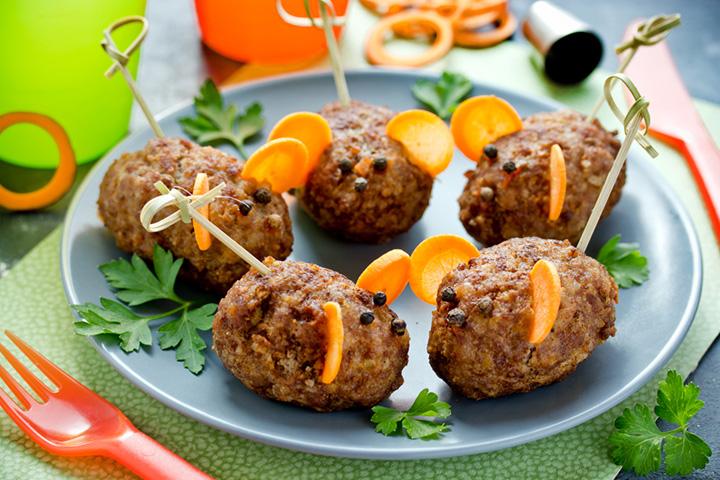Image: Shutterstock
Meatballs are soft-textured, small balls made of chopped or minced meat. They may also contain other ingredients such as eggs, cheese, and veggies. Since meat is the main ingredient in meatballs, babies can get essential nutrients, such as protein and heme iron, from them (1). Besides, they are easy to grab and hold, making them an excellent choice to help a baby learn self-feeding.
If you are a new parent looking for some insight into the safety of meatballs for babies, then read on. This post tells you about the right age to feed your baby meatballs, its possible benefits, precautions to take, and some baby-friendly recipes to try.
When Can Babies Eat Meatballs?
Dr. David Shafran, a pediatrician at Cleveland Clinic and head of Pediatrics at K Health, says,“Meatballs, though soft if cooked well, might initially present a choking hazard and should not be introduced until better chewing skills have developed. In most infants, this would be around nine months of age. Even then, I’d be certain to cut those meatballs into smaller pieces and avoid adding harder foods like onions to the mix. I’d keep it simple with single-ingredient meatballs.”
However, consult your pediatrician if you wish to feed meatballs to your baby earlier than nine months of age. Once your pediatrician approves, you can serve meatballs first in puree or mash forms. Alternatively, you can cut the meatball into small pieces and serve them to your baby for baby-led weaning.
Then, as the baby grows and can hold and eat the food themselves, you can feed them whole meatballs. While you serve your baby meatballs, abstain from using cured (deli meat) meat as they have high fat, sodium, and nitrate content (1). Additionally, if they aren’t cooked well, they raise listeria infection (listeriosis) risk (2). Therefore, avoid feeding processed meat to babies.
Nutritional Overview Of Meatballs
Based on the meat type and seasonings, there are different meatball types. Beef, veal, lamb, chicken, mutton, pork, turkey, and fish are some meats that you can use to make the meatballs. Although different meatball types will have a slightly different nutritional profile, on average, meatballs are a good source of protein, heme iron, vitamin B3, B6, B9, B12, and essential minerals, such as zinc and selenium (1).
Choose a meat type that gives more iron per serving. For instance, red meats, such as beef, lamb, pork, and veal, have high amounts of heme iron (3). Pork and chicken liver have the highest iron content (4).
Possible Benefits OfMeatballs For Babies
Here are some of the vital benefits that a baby may incur from meat intake.
- Offers lean protein: Meat is a source of high-quality protein that can aid in the growth and development of babies. Besides, animal protein is more bioavailable, meaning the baby can get more absorbable protein. Healthy, full-term babies between six and 12 months require 11 to 13 grams of protein per day (5). Feeding babies meatballs can contribute to this requirement.
- Provides several B vitamins: Meat can offer several B vitamins, such as vitamin B1, B2, B3, B6, B9, and B12, to babies. These vitamins play a crucial role in several physiological processes that facilitate healthy growth and development. For instance, vitamin B2 and B3 help in energy metabolism, whereas vitamin B12 helps healthy red cell formation and proper nervous system functioning (1).
- Gives essential nutrients: Heme iron, zinc, selenium, and calcium are vital nutrients that meat can add to a baby’s weaning diet. These help the baby’s body in different functions, such as immune system functioning, proper cognitive development, and overall growth and development (1).
How To Prepare Meatballs For Babies?
Here are some simple tips that you should keep in mind while preparing meatballs for babies.
1. Ensure the meat is well-cooked and soft
It is necessary to make easy-to-swallow meatballs for babies. If meatballs are undercooked, they will have a hard texture, making it difficult for a baby to swallow, raising the choking risk. Besides, it will increase the chances of bacterial, viral, or parasitic infection. Therefore, experts recommend broiling, baking, roasting, braising, pot roasting, or stewing meat.
To ensure the food is cooked to the right temperature, use a food thermometer to check the temperature of the cooked meatball. For instance, thoroughly cooked ground beef, pork, veal, and lamb should measure 160°F (71°C) after removing from the heat source (1). If there are any tough meat portions in the meatball, remove them before feeding to minimize choking risk.
2. Mix meat with veggies and herbs
It enhances the meatball’s nutritional density. You may also give texture to meatballs with bread crumbs. Use whole-wheat bread crumbs or coarse oats flour. Prepare a saltless sauce or gravy using herbs, such as dried oregano, thyme, or basil, and spices,such as cumin and cinnamon, to improve the meatball’s flavor. Add multiple ingredients to meatballs only when the baby is already consuming single-ingredient meatballs comfortably.
3. Keep the portion size small
Small meatballs are easy to hold and eat. However, even with small meatballs, you need to be careful with the size. Introduce minced or finely chopped meatballs to the baby to minimize the choking risk.
As the baby grows, you can gradually modify the meatball serving size age-appropriately.
- For six-month-olds, quarter a small meatball and mash the pieces slightly before serving them to the baby. If the baby is facing difficulty self-feeding, completely mash the meatballs and feed the baby with a spoon.
- For nine-month-olds, serve small pieces of meatballs as finger food to let your baby self-feed. In addition, since meatballs are soft and easy to grab and hold, they can help nine-month-olds hone their pincer grasp.
- For 12-months-olds, you can serve small meatballs in whole. However, if the baby finds it challenging to hold the whole meatball, you can still cut it into halves. Just be sure that the baby is feeding comfortably and isn’t choking or gagging.
Once you know how to prepare meatballs for babies, learn the necessary precautions you should take for safe feeding.
Precautions To Take When Feeding Meatballs To Babies
Observe the following precautions to ensure safe consumption of meatballs by babies:
- Consult your doctor. The first step to feeding meatballs to your baby is to consult a pediatrician, especially if you are unsure about your baby’s oral-motor skill development. The doctor will guide you if meatballs with several ingredients, such as egg and herbs, will be appropriate for your baby or not.
- Prepare meatballs at home. It is vital as most store-bought meatballs are usually high in sodium and may contain additives, such as preservatives, affecting a baby’s health.
- Wash your hands with warm water and soap before and after handling raw meat. It is an essential step to avoid microbial contamination. Remember, babies under five years of age are vulnerable to food-borne illnesses due to their underdeveloped immune systems (6).
- At first, prepare single-ingredient meatballs. For instance, you can begin with ground meat, such as beef or chicken meatballs. Then, once the baby can digest meatballs comfortably, add more ingredients, such as veggies and bread crumbs.
- Be careful about what spices you add to meatballs, “especially at younger ages closer to six months. When introducing foods, you want to do so one at a time to watch for allergies. Introducing a multi-ingredient meatball might confound this picture. Keep it simple initially. Add nuance and complexity later as allergy risk declines and the palate refines,” suggests Dr.Shafran.
- Follow a three-to-five-day wait rule when you first feed meatballs to babies. It’s vital as meat might cause intolerance or allergy in sensitive babies, especially those eating meat for the first time.
- Feed small quantities of about one to two teaspoons of mashed meatball in the beginning. Then, gradually increase the amount to a tablespoon or two once the baby looks comfortable digesting meatballs.
- Discontinue feeding if the baby looks uncomfortable after ingesting the meatballs. Reintroduce at a later date and monitor the baby’s reactions. If the baby still shows discomfort, sensitivity, or intolerance to meatballs, immediately stop feeding meatballs and consult your healthcare provider.
- Stay alert to allergy signs and symptoms. Meatball allergy in babies is uncommon but possible (7). The risk could be higher when serving multi-ingredient meatballs, such as those with cheese and egg. Common signs and symptoms of allergy in babies include hives, itching around the lips and mouth, wheezing and coughing, abdominal pain, vomiting, and diarrhea. A severe allergic reaction could lead to throat tightening and difficulty in breathing, leading to anaphylaxis, which is a medical emergency.
- Never leave your baby unsupervised while they are self-feeding. It’s vital to reduce choking risk, which may occur when babies eat meatballs for the first time, especially semi-thick pieces/chunks.
- Never refrigerate baby’s half-eaten meatballs. It’s essential because bacteria from an infant’s mouth can transfer into the meatballs and affect its safety. However, you can store whole leftover meatballs at an appropriate temperature.
Nutritious Meatball Recipes For Babies And Toddlers
Here are some age-appropriate meatball recipes that you can feed your baby and toddler.
1. Cheesy meatball (6+ months)
You will need:
- ½ cup iron-fortified baby oats
- ½ cup breastmilk
- 1 ¼ lb. beef (medium ground)
- 1 cup cheddar (finely grated)
- 1 egg (beaten)
- 1tsp dried oregano
- 1tsp dried thyme
- ½tsp black pepper powder
How to make:
- Preheat the oven to 400°F (204°C). Grease the baking sheet and set it aside.
- Meanwhile, mix oats with milk in a large bowl and let the mixture sit for ten minutes.
- After ten minutes, add beef, cheese, egg, oregano, thyme, and black pepper. Mix well until everything is combined.
- Take a tablespoon of the mixture in your palm and roll it into small meatballs.
- Once all the meatballs are ready, place them on the baking sheet and put them into the oven.
- Bake the meatballs for 15 minutes until they turn golden brown and crisp. Then, take out the baking sheet from the oven and keep it on the wire rack to cool the meatballs.
- Serve one meatball mashed or cut into small pieces for babies for baby-led weaning. You can also serve these meatballs with stewed veggies, such as pumpkin and zucchini. Alternatively, you can add veggies, such as mashed peas, spinach, and sweet potatoes to this recipe to make the meatballs more flavorsome and nutritious.
2. Meat and veggie meatballs (9+ months)
You will need:
- 200g beef (minced)
- ½ red onion (finely chopped)
- ½ zucchini (coarsely grated)
- ½ carrot (peeled and coarsely grated)
- ¼ cup green peas (boiled and mashed)
- ¼ cup mozzarella cheese
- 1tsp mixed herbs
- Canola oil
How to make:
- Combine minced beef, chopped onions, zucchini, carrot, green peas, and mixed herbs in a bowl. Mix well until everything combines.
- Take a tablespoon of the mixture in your palm and roll it into a small ball. Repeat the process and make meatballs with the entire mixture.
- Place all the meatballs on a plate and cover them with plastic wrap or cling foil. Refrigerate for 30 minutes.
- After 30 minutes, heat two tablespoons of oil in a large frying pan over medium-high heat.
- As the oil warms, put some meatballs on the pan with some spacing and cook then for ten minutes, occasionally turning, until they get well-cooked on all sides and look golden brown.
- Once done, put the meatball on a plate. Cut it into small pieces and serve warm to your baby.
3. Mini meatball in sauce (12+ months)
You will need:
- 300g low-sodium tin tomatoes (drained)
- 100g turkey (minced)
- 1 red onion (finely chopped)
- 2 garlic cloves (finely chopped)
- 1tsp dried mixed herbs
- 1tbsp olive oil
How to prepare:
- Mix garlic and one-fourth of the chopped onions with minced turkey to make a uniform meatball mixture.
- Take out a tablespoon of this mixture into your palm and roll it out into a small ball. Once all the meatballs are ready, place them on a plate.
- Heat the olive oil in a frying pan over medium-high heat. As the oil warms, place a few meatballs onto the pan for pan-frying.
- Fry the meatballs until they are soft and brown on all sides. Once done, remove them from the pan and put them onto a plate.
- Now, add the remaining onions to the frying pan and cook them for two to three minutes until soft. Next, add the remaining garlic, tomatoes, and mixed herbs with about 200ml of water.
- Bring the sauce to a boil, and then add the meatballs. Reduce the flame, lid the pan, and let simmer for around 30 minutes.
- After 30 minutes, turn off the flame and set the pan aside to cool. Feed warm meatball with sauce to your baby with some brown rice.
Meatballs are a nutrient-rich food that can offer high-quality, lean protein, iron, and zinc to babies. You can feed meatballs to babies as soon as they begin eating different solids. Introduce meatballs that are made of single-ingredient, and gradually experiment with multi-ingredient meatball recipes for your baby.


































